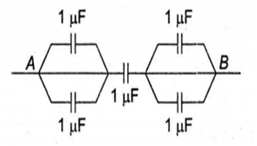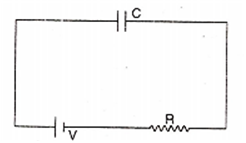CBSE Multiple Choice Questions
Multiple Choice QuestionsTwo capacitors, one 4 pF and the other 6 pF, connected in parallel, are charged by a 100 V battery. The energy stored in the capacitors is
1.2 × 10−8 J
2.4 × 10−8 J
5.0 × 10−8 J
1.2 × 10−6 J
What is the area of the plate of a 3 F parallel plate capacitor, if the separation between the plates is 5 mm?
12.981 x 102 m2
9.281 × 109 m2
1.69 × 1012 m2
4.529 × 109 m2
Equivalent capacity between A and B is

2 µF
3 µF
4 µF
0.5 µF
A sheet of aluminium foil of negligible thickness is introduced between the plates of a capacitor. The capacitance of the capacitor
decreases
remains unchanged
becomes infinite
increases
The diameter of each plate of an air capacitor is 4 cm. To make the capacity of this plate capacitor equal to that of 20 cm diameter sphere, the distance between the plates will be
4 × 10-3 m
1 × 10-3 m
1 cm
1 × 10-3 cm
A capacitor of capacity C is charged by connecting it with R according to the figure. Energy supplied by the battery in this process is :

more than
2CV2
less than
Three capacitors of 3, 2 and 6 µF are connected in series with a battery of 10 V. Then charge on 3 µF capacitor will be
10 µC
12 µC
14 µC
5 µC
The electric potential V is given as a function of distance x (m) by V = (5x2 + 10x − 9) volt. Value of electric field at x=l m is
20 V/m
6 V/m
11 V/m
− 23 V/m
If the energy of a 100 F capacitor charged to 6 kV could all be used to lift a 5O kg mass, what would be the greatest vertical height through which mass could be raised?
0.6 mm
3.6 m
1.2 mm
12 m
Three charged particles are initially in position-1. They are free to move and they come to position-2, after some time. Let U1 and U2 be the electrostatic potential energies in position-1 and 2 then
U1 = U2
U2 U1
U2 > U1
U1 > U2

